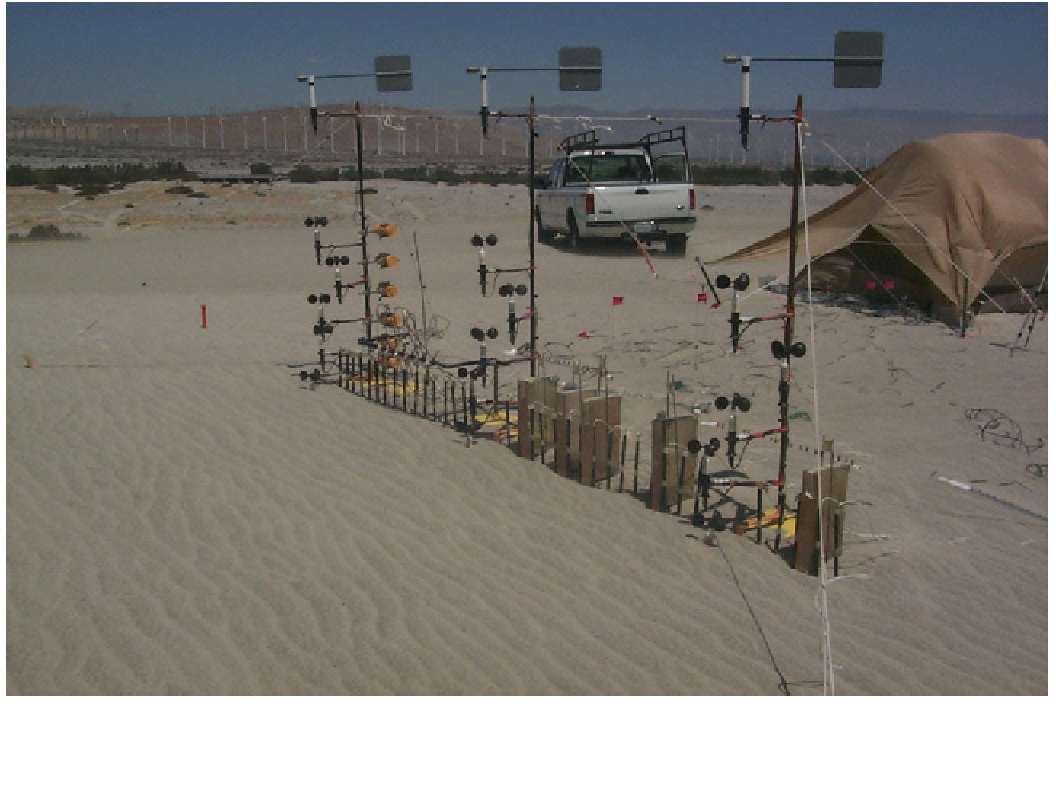Geoscience Reference
In-Depth Information
Fig. 16.13
A modern field experiment can be an orgy of instrumen-
tation. Here we see an array of sand traps (boxes), safire detectors
(narrow cylinders in the ground), cup anemometers and wind vanes. The
data acquisition equipment is prudently protected in a tent (the shade in
which makes laptop screens easier to see). This array, at Windy Point in
California, was used to study turbulent structure in saltation (Baas 2008).
Note the pickup truck, with its left wheels somewhat sunk into the sand,
and the ripples in the foreground. Photo courtesy of Andreas Baas
Coachella Valley in southern California, from which he was
able to obtain direct field measurements of the rates of
abrasion of different materials caused by saltating sand
(Sharp 1964, 1980). One of Sharp's students, Michael
Malin, took this approach to a new level; he placed weighed
samples of sawed rock chips at multiple locations
throughout the dry valleys of Antarctica in order to quantify
the present abrasion rates in this harsh (but Mars-like)
environment. Ronald Greeley brought the study of sand
abrasion into the laboratory by constructing a device that
could repeatedly throw individual sand grains at prepared
targets, under constrained velocities and angles of inci-
dence, providing data on the rate of sand abrasion which
was then extended to the conditions currently present on
Mars (Greeley et al. 1982; Greeley and Iversen 1985, pp.
112-118). Such investigations have proved to be important
foundations for understanding the aeolian abrasion of
individual rocks (producing ventifacts) or large bedrock
exposures (producing yardangs).
Yardangs (a Turkic word) are streamlined erosional wind
forms, similar in form to inverted boat hulls, that in ter-
restrial deserts range from meters to kilometers in length.-
They require very erodible rocks (more typically,
consolidated sediment) in which to form. They have been
observed on Mars (e.g., Ward 1979).
Ventifacts are clasts of rock that have been shaped (often
into triangular 'trikanter' forms) or textured (with pitting or
fluting) by windblown sand. These too have been observed on
Mars (e.g., Bridges et al. 1999; e.g., Fig.
16.14
). A somewhat
analogous process, although with some deposition added to
complicate matters, forms sastrugi in snow surfaces.
An entire book could be written on aeolian erosion.
However, a full discussion of these topics is beyond the
scope of this topic, but there is some good treatment in
Greeley and Iverson (1985), and in Laity and Bridges
(2009). A great (free) resource on rock breakdown in
planetary environments more generally is the photographic
atlas by Bourke and Viles (2007).

Search WWH ::

Custom Search